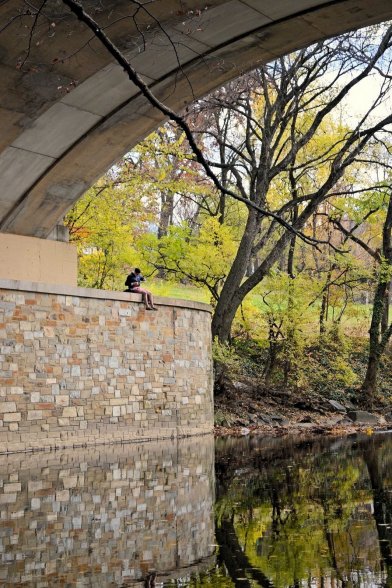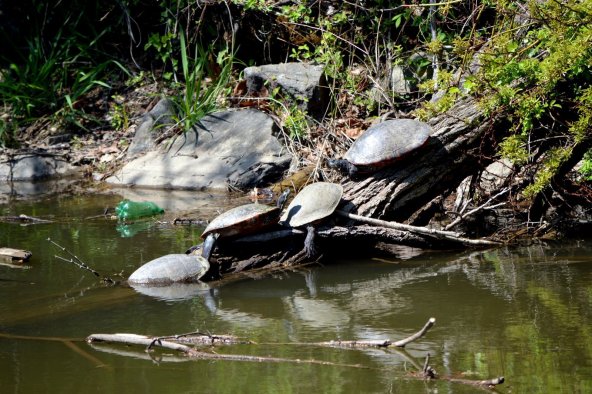Biophilic DC
April 27, 2015
By: Megan Draheim
For the last several months, a working group has worked on bringing the Sense of the Council on Biophilic Cities Resolution of 2015 (PDF) to the Council of the District of Columbia. The group was composed of co-founder Stella Tarney of Dumbarton Oaks Park and the Sustainable Landscape Design Program at George Washington University, Chris Weiss of the DC Environmental Network, Anne Lewis of City Wildlife, John Hadidian of HSUS, and myself, among others.
In early March of this year, under the leadership of Councilmember Mary Cheh, it was co-introduced by all sitting Councilmembers. On April 14th, the Council unanimously passed the resolution (PR21-0095). It declares that:
The District of Columbia supports the principles of the Biophilic Cities Network and commits to promoting, learning about, and sharing biophilic programs and projects with other participating municipalities, to supporting urban biodiversity, and to creating opportunities for all District residents to connect with nature.

Many of us who work on urban biodiversity and sustainability issues have recently become intrigued about the idea of “biophilic cities.” The concept is simple: being around nature is good for people, and many people live in cities. Making cities as nature-rich as possible will also be good for biodiversity, given our rapidly urbanizing world. But of course the devil is in the details, and that’s where it can become tricky.
Tim Beatley at the University of Virginia wrote a book (aptly named Biophilic Cities) a few years back that helped launch a worldwide movement, resulting in the Biophilic Cities Network. I’m proud to be one of the co-founders of the Biophilic DC Working Group that is seeking to have Washington, D.C. become part of this truly international network: member cities range from Vitoria-Gasteiz, Spain to Wellington, New Zealand, to the city-state of Singapore. In the U.S., Milwaukee, Phoenix, Portland, and San Francisco are all members. One of the most important benefits of being a part of this network is to be able to share best practices with each other – what worked, what didn’t work, and perhaps some insight into why. That will be of tremendous help here in D.C. because, as I mentioned at the start, the devil truly is in the details.

The Resolution defines a biophilic city as:
A city of abundant nature, where residents, young and old, have rich daily contact with the natural environment no matter where they reside; where larger natural areas and deeper natural experiences are an easy walk, bike, or transit ride away; and where the urban environment allows for and fosters connections with diverse flora and fauna. In biophilic cities, residents recognize, respect, are curious about, and actively care for the nature around them, and they spend extensive time outside learning about, enjoying, and participating in the natural world.
In biophilic cities, leaders and elected officials give nature and natural capital a central place in their decision making, and evaluate their planning and development decisions by the extent to which nature is restored and protected, and connections with the natural environment enhanced. Leaders and residents of biophilic cities recognize that proximity to nature makes for more desirable communities and provides numerous benefits to all.
A biophilic city recognizes the important role cities play in protecting and increasing biodiversity in a world where biodiversity is greatly threatened.
In D.C. we’re already well on our way to being a Biophilic City. We have abundant greenspace throughout much of the city, and our two rivers provide a great deal of habitat for a variety of species. But that doesn’t mean we don’t have room for improvement. Access to nature isn’t equitable across the city, and many lower income neighborhood residents do not get the same benefits of being surrounded by healthy trees, plants, and wildlife that residents in higher income neighborhoods often do.
The benefits of being around nature are well documented. There’s a wealth of literature on the link between access to nature and human health and well-being, both physically and mentally – everything from boosting academic performance in students to shortening hospital recovery rates (PDF) to decreasing the physical symptoms of stress.

The flip side, if you will, to the benefits humans can accrue are the benefits to non-human flora and fauna. We’re facing a biodiversity extinction crisis across the planet, and while historically many people believed that cities were impoverished spaces from a biodiversity perspective, cities can actually provide valuable habitat for a wide variety of species. We can be part of the solution by building biophilic cities — making our cities more biodiverse-friendly by being more thoughtful to our non-human neighbor’s needs (although many species do quite well among us without our help). For example, traditional green roofs are great for stormwater retention, but in many cases they can also double as wildlife habitat with some forethought. As a conservation biologist with a focus on urban environments and a life-long urban resident, both the human and nonhuman sides are important to me.
Working with the D.C. Council on the Biophilic Cities Resolution was our first goal, and a big step towards having D.C. join the Biophilic Cities Network. We’re now are in the process of planning our next steps, which will include some combination of collaborative work with existing organizations, public outreach and education, and research.
Participating in initiatives like this provides great material for the courses I teach at the Center for Leadership in Global Sustainability (CLiGS), which include Conservation Ecology, Human-Wildlife Conflict, and Urban Wildlife. I’ve had students do independent studies related to biophilic cities themes, and I’m hoping that I’ll have opportunities for CLiGS students to be able to join us in our efforts over time, both virtually and in-person. From an educational perspective, these types of real-life experiences and opportunities in the newly developing and expanding field of urban conservation can be invaluable. If you’re interested in following along in our progress, I’ll be blogging about it on a regular basis at www.OurUrbanJungle.wordpress.com!


